Multiphysics Investigation of an UltrathinVehicular Wireless Power Transfer Module for Electric Vehicles
Abstract
:1. Introduction
2. Proposed Wireless Power Transfer System
3. Proposed Ultrathin CPM
3.1. Design and Manufacturing
3.2. Electromagnetic and Thermal Specifications
4. Electromagnetic–Thermal Simulation
4.1. Component Level
4.1.1. Litz Wire
4.1.2. Ferromagnetic Sheet
4.1.3. Shielding
4.2. Module Level
4.3. System Level
5. Experimental Validation
5.1. Component Level
5.2. Module Level
5.3. System Level
6. Results and Discussion
6.1. Component Level
6.2. Module Level
6.3. System Level
7. Conclusions
Author Contributions
Funding
Institutional Review Board Statement
Informed Consent Statement
Conflicts of Interest
Abbreviations
| AC | Alternating current |
| CPM | Car Pad Module |
| DC | Direct current |
| EVs | Electric vehicles |
| GPM | Ground Pad Module |
| HF | High frequency |
| HiL | Hardware-in-the-Loop |
| HV | High voltage |
| MOSFET | Metal–oxide–semiconductor field-effect transistor |
| PET | Polyethylene terephthalate |
| PFC | Power factor correction |
| RMS | Root mean square |
| WPTS | Wireless power transfer system |
References
- Fett, D.; Ensslen, A.; Jochem, P.; Fichtner, W. A Survey on User Acceptance of Wireless Electric Vehicle Charging. World Electr. Veh. J. 2018, 9, 36. [Google Scholar] [CrossRef] [Green Version]
- Khutwad, S.R.; Gaur, S. Wireless charging system for electric vehicle. In Proceedings of the 2016 International Conference on Signal Processing, Communication, Power and Embedded System (SCOPES), Paralakhemundi, India, 3–5 October 2016; pp. 441–445. [Google Scholar] [CrossRef]
- Zimmer, S.; Rothenberg, S.; Tattko, B.; Baumer, T.; Baier, K.; Glöggler, C.; Anja, W.; Niels, M. Vehicle Integration of wireless power transfer systems: An experimental safety investigation of underfloor impact scenarios. In Proceedings of the 31th International Electric Vehicle Symposium & Exhibition (EVS31), Kobe, Japan, 1–3 October 2018. [Google Scholar]
- Barth, H.; Jung, M.; Braun, M.; Schmuelling, B.; Reker, U. Concept Evaluation of an Inductive Charging System for Electric Vehicles. In Smart Grids and E-Mobility; Stoa, P., Günther, E., Eds.; Ostbayerisches Technologie-Transfer-Institut (OTTI): Regensburg, Germany, 2011. [Google Scholar]
- Onar, O.C.; Campbell, S.L.; Seiber, L.E.; White, C.P.; Chinthavali, M. Vehicular integration of wireless power transfer systems and hardware interoperability case studies. IEEE Trans. Ind. Appl. 2019, 55, 5223–5234. [Google Scholar] [CrossRef]
- Zimmer, S.; Lucas, P.; Helwig, M.; Winkler, A.; Modler, N. Systematic engineering of functionally integrated wireless power transfer systems for electric vehicles. Procedia Manuf. 2020, 52, 241–249. [Google Scholar] [CrossRef]
- Bosshard, R.; Kolar, J.W. Multi-Objective Optimization of 50 kW/85 kHz IPT System for Public Transport. IEEE J. Emerg. Sel. Top. Power Electron. 2016, 4, 1370–1382. [Google Scholar] [CrossRef]
- Moghaddami, M.; Sarwat, A. Time-Dependent Multi-Physics Analysis of Inductive Power Transfer Systems. In Proceedings of the 2018 IEEE Transportation Electrification Conference and Expo (ITEC), Long Beach, CA, USA, 13–15 June 2018; pp. 130–134. [Google Scholar] [CrossRef]
- Zhu, C.; Fu, C.; Wang, D.; Huang, X.; Zhang, H.; Dong, S.; Wei, G.; Song, K. Thermal Simulation and Optimization Study for Magnetic Coupler of Static Electric Vehicle Wireless Power Transfer Systems. In Proceedings of the 2019 22nd International Conference on Electrical Machines and Systems (ICEMS), Harbin, China, 11–14 August 2019; pp. 1–4. [Google Scholar] [CrossRef]
- Zimmer, S.; Helwig, M.; Lucas, P.; Winkler, A.; Modler, N. Investigation of Thermal Effects in Different Lightweight Constructions for Vehicular Wireless Power Transfer Modules. World Electr. Veh. J. 2020, 11, 67. [Google Scholar] [CrossRef]
- Dolara, A.; Leva, S.; Longo, M.; Castelli-Dezza, F.; Mauri, M. Coil design and magnetic shielding of a resonant wireless power transfer system for electric vehicle battery charging. In Proceedings of the 2017 IEEE 6th International Conference on Renewable Energy Research and Applications (ICRERA), San Diego, CA, USA, 5–8 November 2017; pp. 200–205. [Google Scholar] [CrossRef]
- Alsayegh, M.; Saifo, M.; Clemens, M.; Schmuelling, B. Magnetic and Thermal Coupled Field Analysis of Wireless Charging Systems for Electric Vehicles. IEEE Trans. Magn. 2019, 55, 1–4. [Google Scholar] [CrossRef]
- Biela, J. Wirbelstromverluste in Wicklungen Induktiver Bauelemente; Skriptum, ETH Zürich: Zürich, Switzerland, 2012. [Google Scholar]
- Liang, C.; Yang, G.; Yuan, F.; Huang, X.; Sun, Y.; Li, J.; Song, K. Modeling and Analysis of Thermal Characteristics of Magnetic Coupler for Wireless Electric Vehicle Charging System. IEEE Access 2020, 8, 173177–173185. [Google Scholar] [CrossRef]
- Bosshard, R.; Kolar, J.W.; Muhlethaler, J.; Stevanovic, I.; Wunsch, B.; Canales, F. Modeling and h-a-Pareto Optimization of Inductive Power Transfer Coils for Electric Vehicles. IEEE J. Emerg. Sel. Top. Power Electron. 2015, 3, 50–64. [Google Scholar] [CrossRef]
- Bosshard, R. Multi-Objective Optimization of Inductive Power Transfer Systems for EV Charging. Ph.D. Thesis, ETH Zürich, Zürich, Switzerland, 2015. [Google Scholar] [CrossRef]
- Kim, S.; Amirpour, M.; Covic, G.; Bickerton, S. Thermal Characterisation of a Double-D Pad. In Proceedings of the 2019 IEEE PELS Workshop on Emerging Technologies: Wireless Power Transfer (WoW), London, UK, 18–21 June 2019; pp. 1–5. [Google Scholar] [CrossRef]
- Niu, S.; Yu, H.; Jian, L. Thermal Behavior Analysis of Wireless Electric Vehicle Charging System under Various Misalignment Conditions. In Proceedings of the 2020 IEEE 4th Conference on Energy Internet and Energy System Integration (EI2), Wuhan, China, 30 October–1 November 2020; pp. 607–612. [Google Scholar] [CrossRef]
- Society of Automotive Engineers. (R) Wireless Power Transfer for Light-Duty Plug-In/Electric Vehicles and Alignment Methodology; SAE International: Warrendale, PA, USA, 2019. [Google Scholar]
- Hameed, Z.; Oien-Rochat, M.; Bruzzone, C.; Cummings, I.; Keeney, J.; Benson, M. Thin, Light & Flexible Magnetic Materials for 7.7 kW Wireless Power Transfer System. In Proceedings of the 2019 IEEE Wireless Power Transfer Conference (WPTC), London, UK, 18–21 June 2019; pp. 612–615. [Google Scholar] [CrossRef]
- Ferroxcube. Soft Ferrites: Ferrite Material Survey; Ferroxcube: Hong Kong, China, 2020; Available online: https://ferroxcube.home.pl/prod/assets/sfmatgra_frnt.pdf (accessed on 1 August 2021).
- Huntsman Advanced Materials GmbH. Data Sheet: Advanced Materials—Araldite CW 2243-2 L/Aradur HY 2966; Huntsman Advanced Materials GmbH: The Woodlands, TX, USA, 2012. [Google Scholar]
- Ashby, M.F. Composite Materials, Microstructural Design of. In Encyclopedia of Materials: Science and Technology; Elsevier: Amsterdam, Netherlands, 2001; pp. 1357–1361. [Google Scholar] [CrossRef]
- Cu-ETP. Deutsches Kupferinstitut: Düsseldorf, Germany, 2020. Available online: http://te-x-te.de/images/DA_DKI.pdf (accessed on 1 August 2021).
- Kern GmbH. Polyamid 6 (PA 6); Kern GmbH: Grossmaischeid, Germany, 2020. [Google Scholar]
- Paoli, G.; Biro, O.; Buchgraber, G. Complex representation in nonlinear time harmonic eddy current problems. IEEE Trans. Magn. 1998, 34, 2625–2628. [Google Scholar] [CrossRef]
- InfraTec GmbH. VarioCAM’HD Head: Infrarot-Thermografiesystem für den Industrie– und Laboreinsatz; InfraTec GmbH: Dresden, Germany, 2020. [Google Scholar]
- Cosinus Messtechnik GmbH. Data Sheet: CWT Mini; Cosinus Messtechnik GmbH: Taufkirchen, Germany, 2020. [Google Scholar]
- Weidmann Technologies Deutschland GmbH. TS2: Fiber Optic Temperature Sensor; Weidmann Technologies Deutschland GmbH: Dresden, Germany, 2020. [Google Scholar]

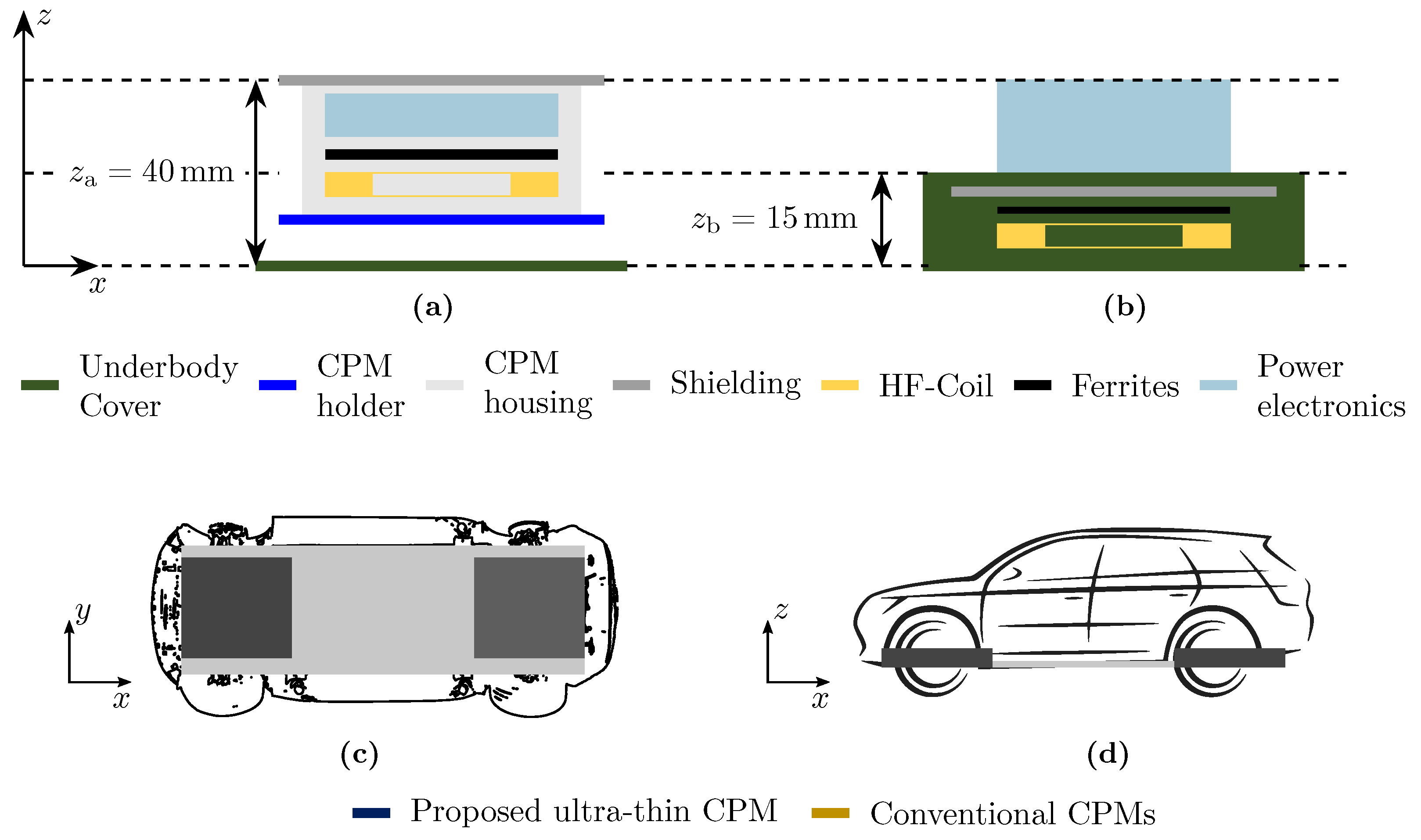
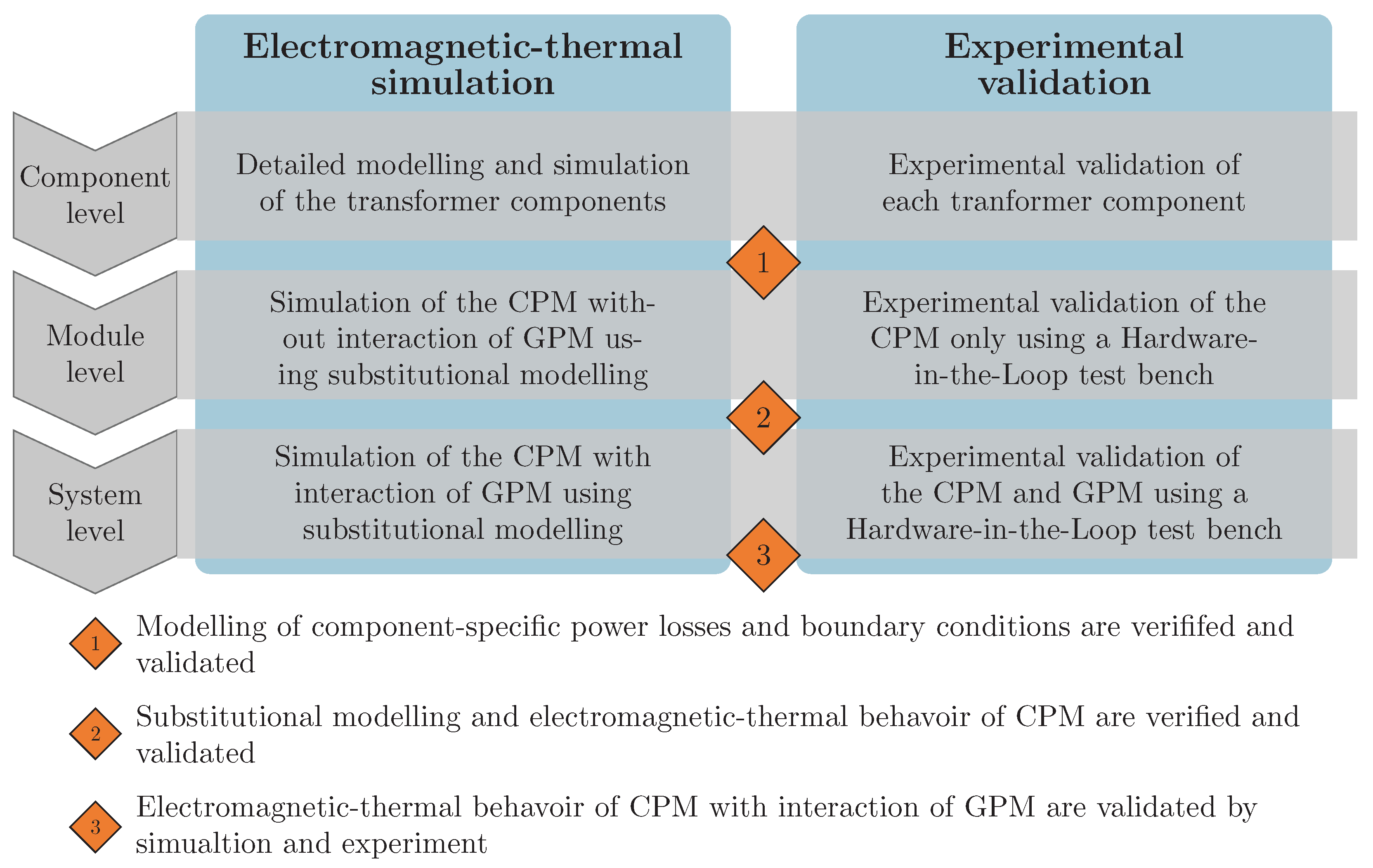








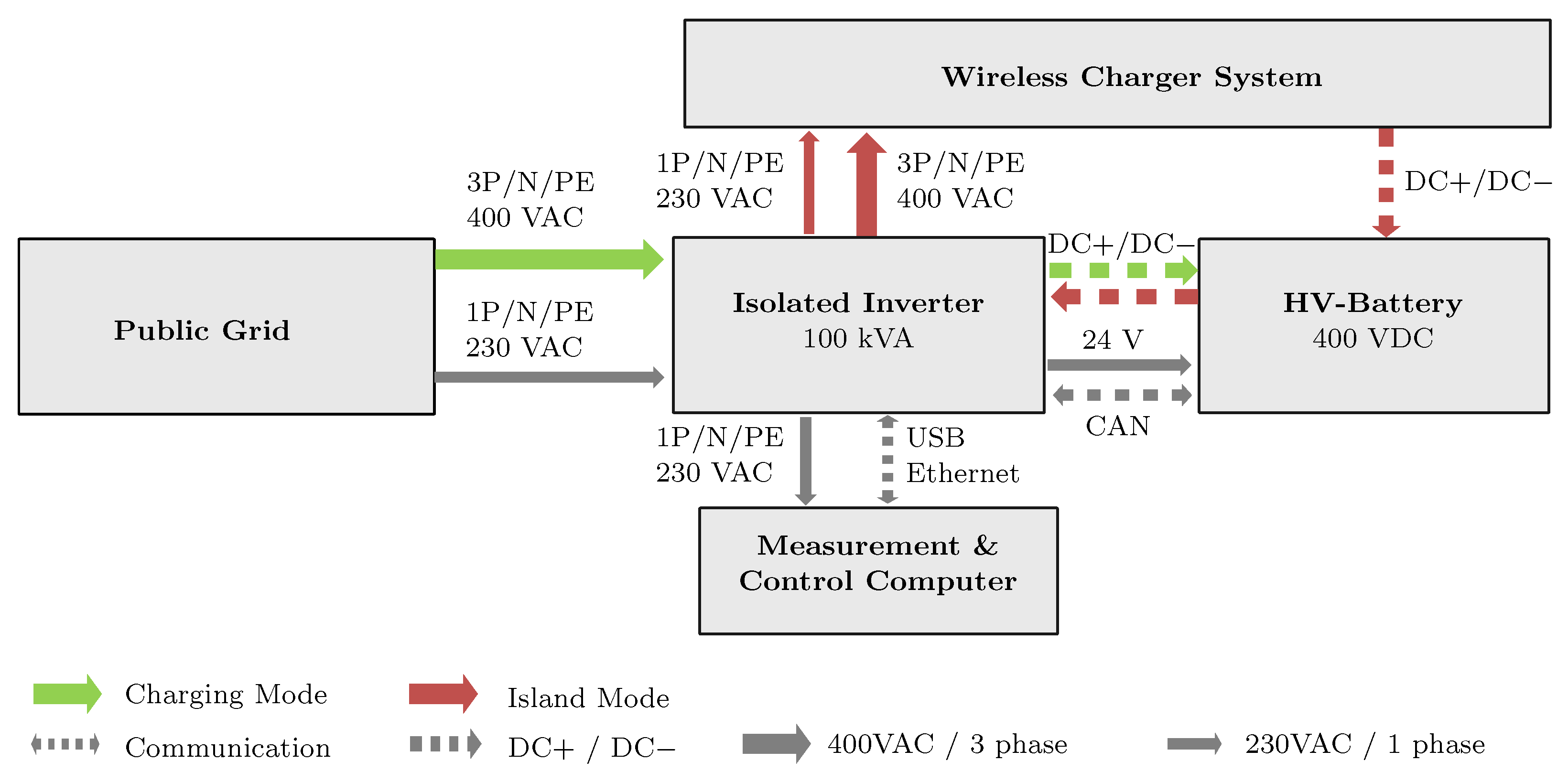

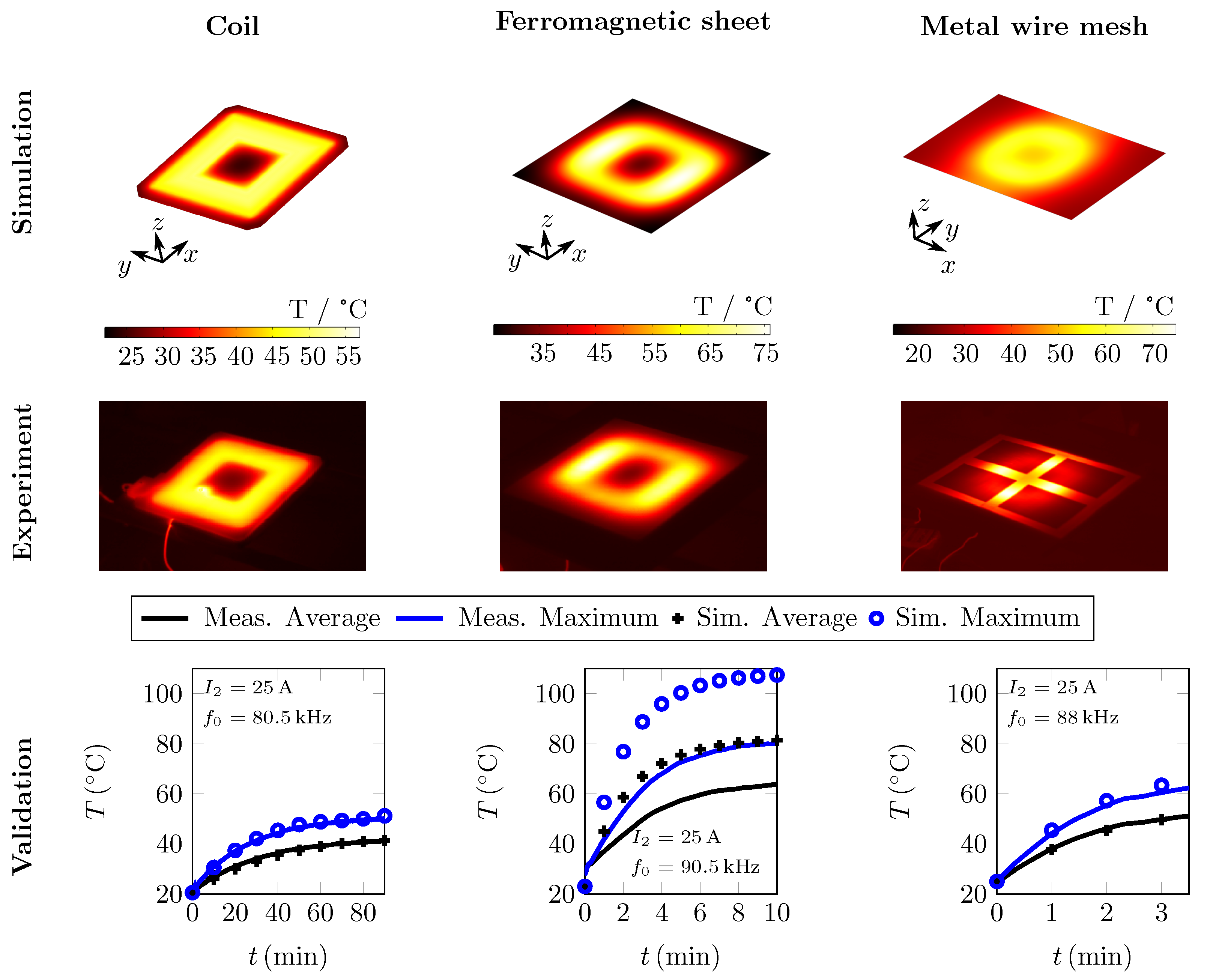

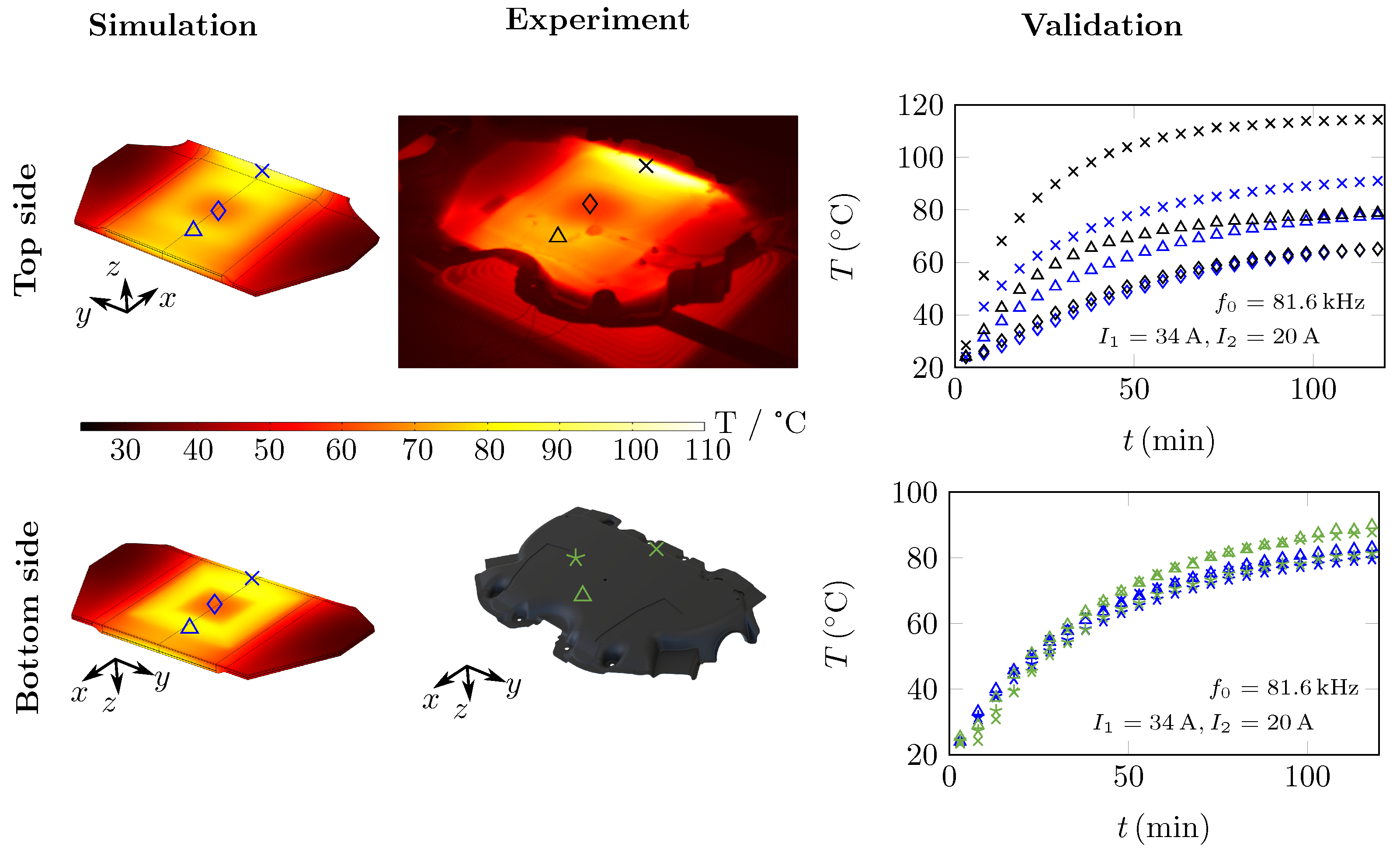

| Parameter | Variable | Value | Unit |
|---|---|---|---|
| Output power | 7.2 | kW | |
| GPM DC link voltage | 0–540 | V | |
| CPM DC link voltage | 300–470 | V | |
| Battery voltage | 300–470 | V | |
| Transmission distance | s | 100–210 | mm |
| Misalignment longitudinal | ±75 | mm | |
| Misalignment transversal | ±150 | mm | |
| Transmission frequency | 81.38–90 | kHz | |
| Area of CPM coil | 300 × 300 | mm2 |
| Parameter | Variable | Value | Unit |
|---|---|---|---|
| Coil length | 500 | mm | |
| 300 | mm | ||
| Coil width | 650 | mm | |
| 300 | mm | ||
| Number of windings | 13 | ||
| 15 | |||
| Self-inductance | 110 | µH | |
| 112 | µH | ||
| Mutual Inductance | M | 7.6–24.3 | µH |
| Magnetic Coupling | k | 0.08–0.22 | |
| AC resistance | <50 | m | |
| 100 | m | ||
| RMS current | 20–50 | A RMS | |
| 23–36 | A RMS |
| Volume Fraction | Density | Heat Capacity | Thermal Conductivity | Electric Conductivity | Relative Permeability | |
|---|---|---|---|---|---|---|
| [-] | [g cm] | [J kgK] | [W mK] | [S m ] | [1] | |
| HF copper coil | 1 | 4.61 | 803 | 166 | - | 1 |
| Copper [24] | 0.41 | 8.92 | 385 | 381 | 1 | |
| CW 2243-2L [22] | 0.59 | 1.56 | 1800 | 0.76 | 130 | 1 |
| Ferromagnetic sheet | 1 | 1.93 | 560 | 7.5/0.46 * | 0 | 1200/3 * |
| Ferromagnetic layer | 0.67 | 2.21 | 730 | 11.2 | 0 | 1800 ** |
| PET layer | 0.33 | 1.38 | 219 | 0.16 | 0 | 1 |
| Shielding | 1 | 4.69 | 678 | 88.5 | 13.2 × 10−6 | 1 |
| Copper mesh | 0.42 | 8.92 | 385 | 88 | 13.2 × 10−6 | 1 |
| CW 2243-2L [22] | 0.58 | 1.56 | 1100 | 0.67 | 0 | 1 |
| CW 2243-2L [22] | 1 | 1.58 | 1800 | 0.67 | 130 | 1 |
| PP GF40 LFT [25] | 1 | 1.22 | 1400 | 0.28 | 130 | 1 |
| Litz Wire | Ferrite Sheet | Shielding | |||||
|---|---|---|---|---|---|---|---|
| Current excitation | [A RMS] | 20 | 25 | 20 | 25 | 20 | 25 |
| Measured loss power | [] | 22 | 34 | 44 | 70 | 50 | 79 |
| Calculated loss power | [] | 18 | 28 | 42 | 66 | 47 | 78 |
Publisher’s Note: MDPI stays neutral with regard to jurisdictional claims in published maps and institutional affiliations. |
© 2021 by the authors. Licensee MDPI, Basel, Switzerland. This article is an open access article distributed under the terms and conditions of the Creative Commons Attribution (CC BY) license (https://creativecommons.org/licenses/by/4.0/).
Share and Cite
Helwig, M.; Zimmer, S.; Lucas, P.; Winkler, A.; Modler, N. Multiphysics Investigation of an UltrathinVehicular Wireless Power Transfer Module for Electric Vehicles. Sustainability 2021, 13, 9785. https://doi.org/10.3390/su13179785
Helwig M, Zimmer S, Lucas P, Winkler A, Modler N. Multiphysics Investigation of an UltrathinVehicular Wireless Power Transfer Module for Electric Vehicles. Sustainability. 2021; 13(17):9785. https://doi.org/10.3390/su13179785
Chicago/Turabian StyleHelwig, Martin, Steve Zimmer, Peter Lucas, Anja Winkler, and Niels Modler. 2021. "Multiphysics Investigation of an UltrathinVehicular Wireless Power Transfer Module for Electric Vehicles" Sustainability 13, no. 17: 9785. https://doi.org/10.3390/su13179785






